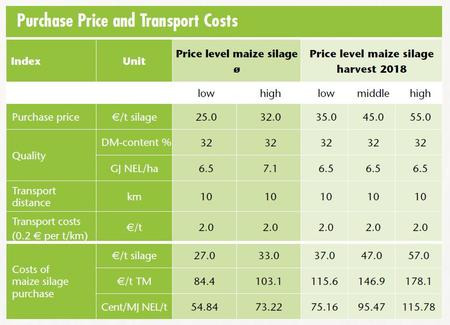International
Wholecrop silage: When is wholecrop rye silage worthwhile?
After the forage maize harvest in the year 2018 many farms had to face the fact that they could not secure their forage supply. Apart from low yields extremely variable qualities had an effect on cattle feeding. Therefore, the issue of wholecrop cereal silage, especially with hybrid rye, received again more attention. In the framework of the MyRye project Fenja Asmussen investigates into the question when wholecrop rye is worthwhile!
Wholecrop cereal silage can help to breech a supply shortfall, to lengthen maize crop rotations and to improve yield security of maize grown on marginal sites. Especially hybrid rye is suitable for wholecrop silage due to its low site requirements and low production costs combined with a high yield potential.
If a feed shortage is foreseeable the use of rye as wholecrop or for grain production can be decided on comparatively short-term. The so called dual-purpose hybrids are characterised by their high crop density, good tillering and good health as well as delayed senescence. In order to decide on the economic feasibility calculations are necessary that reflect the farm individual character and present decision scenario. Usually it has to be decided short-term if rye is harvested or ensiled. A general recommendation cannot be given due to the individual circumstances. However, there are some aspects this year which let the use of winter rye for forage production make economic sense.
Purchase or wholecrop silage production?
The decision if a cash crop is used to feeding livestock depends in the period June/July on three factors:
- Market price and gross margin of cash crop,
- farm individual costs for the alternative use as wholecrop,
- purchasing price of forage (usually ensiled forage maize) including transport costs.
2. The next step would be to calculate the costs deriving from using rye as silage: As there is a relation between grain and wholecrop yield the possible wholecrop yield can be estimated realistically. For the calculation a dry matter content of 35 % and an ENERGY content of 5.8 MJ NEL/kg DM were assumed. However, when winter rye is used as feed on one hand its market value is lost but on the other hand harvest costs are saved (Table 1). In this example the cost for wholecrop rye silage are at approx. 120 Euro per t DM and at 70 Cent NEL MJ/t.
3. It is very important in order to be able to evaluate the economy of wholecrop rye silage to determine the forage purchase and transport prices, in this case forage maize. For the example calculation in Table 2 it was assumed that due to the low forage maize yields in the year 2018, especially in North-Germany, prices are higher than average even at low to medium qualities. The cost per t/DM varies between 110 and 180 Euro, while costs for NEL MJ/t are between 70 and 120 Cent. In our example costs per unit ENERGY density and dry matter are lower for rye than for forage maize. As more expensive the forage purchase and as further the transport as sooner the decision should fall for wholecrop rye.
| Prof. Dr. Katrin Mahlkow-Nerge, University of Applied Science Kiel, department agriculture: “General recommendations on the proportion of wholecrop silage in feed rations depend on the ENERGY content and can be up to 20% for beef production, 10 –kg DM/day for dairy cows and 20% of DM uptake of beef cattle over 200kg. Thus, it is essential to determine the nutritional value by analysis and not to relay on tabular values. Latter often underestimate the ENERGY content. In general wholecrop rye shows a lower ENERGY content than wheat. This mainly derives from the unfavourable grain:straw ratio of rye. Therefore, wholecrop rye is mostly used for feeding early dry cows and big heifers. Commonly beef cattle and lactating cows need ENERGY contents way over 6 MJ NEL/kg DM, which limits the use of wholecrop rye. Wholecrop rye can also be an alternative for bigger farms which introduce a third feeding group for late lactating cows. Another possibility is to combine wholecrop silage with grass silage. Wholecrop silage delivers rumen available starch to the feed ration and a low (partly also negative) ruminal-nitrogen balance (RNB) so that the very high RNB of grass silage can be decreased by wholecrop rye. The starch of the wholecrop rye delivers readily available ENERGY to the rumen and the grass silage fast protein.” |
Evaluation of nutritional value
In general wholecrop silage shows in all cereals only low crude protein values of 7.4 to 8.7 % of DM. Therefore, if used in cattle diets protein has to be calculated accordingly. Wholecrop silage with crops like rye and triticale, which have long straw, have a starch content of about 14 to 17 %. If the straw is short like in barley and wheat the starch content in the dry matter is about 17 to 20 %. Cereal starch is instable and therefore readily available in the rumen. This has to be considered when planning the diet.
The crude fibre content depends on the grain:straw ratio and the degree of maturity at harvest. There is a close relation between crude fibre content and starch content on the one side and the estimated ENERGY content on the other. As higher the crude fibre content as lower the digestibility and as lower the metabolisable ENERGY value. As higher the grain yield and as lower the straw ratio as higher the ENERGY content. Straw length can still be adjusted at harvest by cutting higher.
| Dr. Max Holstermann, product management cattle SALVANA Tiernahrung GmbH “Ensiling additives ensure and speed up the ensiling process. However, they cannot replace good ensiling management. By choosing the right ensiling additive ENERGY losses during fermentation and the risk of faulty fermentations can be reduced as well as the risk of reheating and mold growth. Like that high quality forage can be optimally ensured from field to feeding table.” |
Securing nutritional values
Harvest is carried out at a DM content of 30-35%, which is optimal for ensiling. The DM content cannot be pinpointed to a certain development stage the plant is in but in general it is achieved during milk and dough development. The ripening process from the milk development onwards has to be closely watched, as if the weather is hot and dry, ripening can proceed very quickly so that already during milk development a DM content of 40% can be reached. Optimal ensiling cannot be guaranteed if DM values are above 40%. In that case grain use should be reconsidered.
Short chop length (<8 mm) and a high clamp consolidation are a key factor ensuring aerobic stability of silage. At harvest shredding of straw and knots has to be guaranteed and all grains have to be grinded by a cracker. Undamaged grain passes the digestion tract intact and ends up undigested in the faeces. Harvest mistakes cannot be corrected anymore neither in the silage clamp nor shed!
Summary
In the case of feed shortage wholecrop rye can be a lucrative option. The question if this year rye is used for silage or harvested is mainly influenced by market prices, the gross margin (- permanent labour costs) of the cash crop, farm individual costs for the alternative use as wholecrop and the purchasing price of forage. This year there are some economic aspects that seem to let the option of producing wholecrop rye be sensible. Wholecrop rye silage can be valuable roughage if forage harvesting and ensiling have been carried out according to good agricultural practice.






